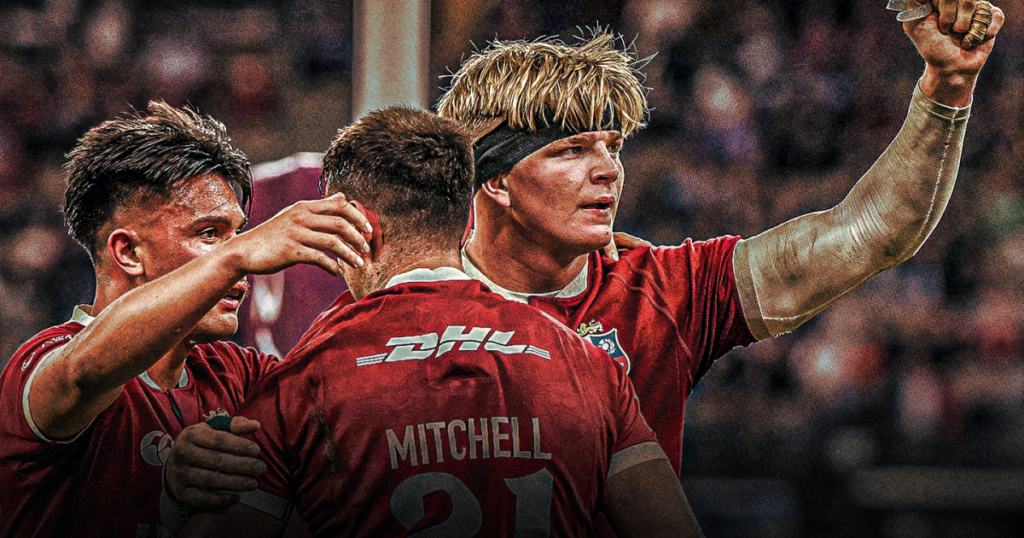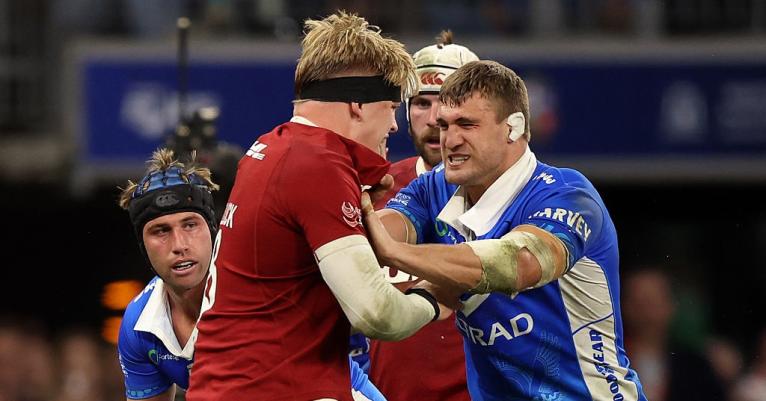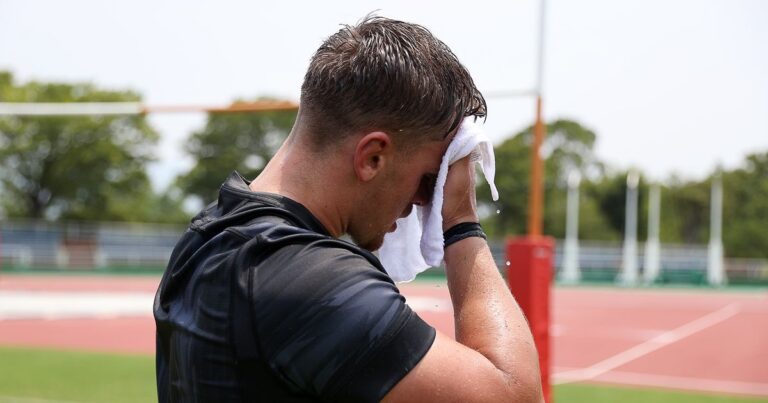
Remember those visits to the zoo as a youngster? I could not wait to wander over towards the enclosures where the big cats roamed. I can recall a couple of my school chums, 11 years old and fresh off the bus, teasing a Bengal tiger through the bars at Chessington. The striped beast suddenly turned on its heel, and a guttural drawl emerged from an echo chamber deep inside. Boom! My friends flew back from the blast. Their eyes were as wide as saucers but their hearts had shrunk to the size of peas.
Order in the big cat kingdom had been restored. Usually, it was enough for a lion to open its mouth wide, and simply yawn – with its massive canines on show – for the gathering crowd to take a short step backwards. An uneasy broth in the belly arose, in equal parts curiosity and naked fear. There was a new and invisible sense of boundaries.
The British and Irish Lions, meanwhile, have been busy setting down some borders of their own in Australia. The 54-7 victory over the Western Force may have been something between a yawn and a roar in terms of pure performance, but it was reinforced by events earlier in the week. On the Monday before the first tour game, Lions CEO Ben Calveley insisted as many Wallabies as possible be released for the provincial games.

“The [pre-tour] agreement [with Rugby Australia] is very clear,” he stated. “It says that Test players have to be released to play in the fixtures leading into that Test series, and so that’s our expectation.
“I think it’s really important that these games are competitive.
“And it’s not just from a performance standpoint. The players do want to test themselves, and they do want to build towards the Test series.
“It’s also right for the fans and for the broadcasters and the partners who are all expecting competitive fixtures, and for the rugby-loving public here in Australia.”
While some common sense needs to be applied, with the Wallabies already in camp and preparing for their warm-up fixture against Fiji in Newcastle on 6 July, there is no doubt the core of Calveley’s case is entirely legitimate.

Over two tours apiece of each southern hemisphere nation, the average score posted in provincial games by the Lions is 30-16 in New Zealand, 39-19 in South Africa, and wait for it, 51-17 in Australia. That was the source of Calveley’s concern, whatever misgivings there may be about the timing and manner of delivery.
While the Brumbies can always be relied upon to provide a stern test, losing 30-28 in the very last minute of the game to the 2001 tourists and winning another nailbiter 14-12 a dozen years later, the cumulative record for the Force, Reds and Waratahs makes for sad reading: an average score of 56-14 over seven matches, with the closest margin Queensland’s 10-point loss to the 2013 Lions. With the viability of future tours in view, a pride of Lions drawn from the cream of the four home unions needs to feel the clash of iron on iron; to meet Australian provinces showing some true pride in competitive performance.
Otherwise, Argentina or even France may enter the Lions conversation. Calveley again:
“We remain open to having discussions about what the future for the Lions may hold, but those conversations are for another time.
“You can certainly understand why people will get excited about the concept [of a series in France].
“What’s not to like about some of those wonderful clubs you could play against, and some of those wonderful venues in the summer time as well?”
The eminences grises of the Aussie punditry world have done their darnedest to hijack the narrative, with Stan Sport’s Morgan Turinui, and ex-internationals Matt Burke, Tim Horan and Michael Hooper, all forecasting a 2-1 series win for the Wallabies, while David Campese predictably pushed his chips all-in on 3-0 to the green and gold.
The scoreline reads 10-6 to the home unions over the past four matches between the Wallabies and England, Ireland, Scotland and Wales, and that blows out to 9-3 if you exclude Wales, who only have one solitary player remaining on the 2025 tour party after the unfortunate injury to Tomos Williams. It still cut no ice with ex-Wallaby scrum-half Will Genia: “if we can play the game at pace and make it a bit loose… individually, we’ve got better athletes”.
At the tactical and technical level of the game, this is probably the biggest misconception of all, and it could yet lead the Wallabies down the wrong road, or up the garden path in the Test series. The notion Australia produces better individual athletes and can play the game quicker and more accurately than the nations in the north when it gets ‘a bit loose’ may have had real substance in the amateur era, and most especially on the cusp of professionalism around 1995, but in the present day it is simply an outdated view.
The league in which Australian teams participate, and have yet to fully make their mark, is Super Rugby, and it does not generate outstandingly better numbers than the English Premiership.

The players produced by the Prem and the URC now have high-quality skill-sets, and the fitness levels to make those skills count. At the Optus Stadium in Perth last Saturday, the Force were not beaten principally at scrum and lineout, the traditional preserves of the north, but in reactions to, and the skills to make the most of, broken play scenarios. They also wound down far quicker than the visitors under the pressure of fatigue, losing the second half 33-0 after putting up a creditable show in the first period.
Although Carlo Tizzano, Jeremy Williams and Harry Potter were away with the Wallabies, at least the Force scrum was fortified by the picks of Oli Hoskins at tight-head and Brandon Paenga-Amosa at hooker, and that duo along with Tom Robertson at loose-head were able to take the fight to the Lions’ starting front-row.
Kiwi referee Ben O’Keeffe sensibly resists the temptation to blow his whistle and asks the scrum to play through, but if anyone is going to win a pen it is the Force, with Lions hooker Dan Sheehan the first to pop his head out of the set-piece under pressure.
When the Lions’ two best pure scrummaging props [Andrew Porter and Will Stuart] came off the pine in the last half hour, that advantage trickled away into the Swan River.
But it was the Lions’ alertness and flexibility in open play which caused their opponents the most inconvenience. The tourists started with a 13-phase kick return featuring left wing James Lowe playing at first receiver, then over on the opposite wing on the scoring play.
It could just as easily have been Mack Hansen, going in the other direction. Joe Roff might have been able to perform that wide mix of roles in his heyday, but are there any wings in the Wallaby squad who could do it as effectively as Lowe? I doubt it.
Lowe was also at the heart of a second-half counterattack try from well inside the Lions 22 – another aspect of play which is not supposed to be a northern speciality.
The other selection which undermines Genia’s view is the presence of 20 year-old Henry Pollock, one of no fewer than five natural number sevens picked in the back-row.
The Lions taking a tap penalty from in front of the posts fully 35 metres from the opposing goal line? Surely not. But you can do it when you have sevens as mobile and intelligent in support as Pollock. In the second clip, both the Lions’ open-sides [Pollock and Josh van der Flier] combine with a couple of neat transfers springing the Northampton man into open prairie, and there is no chance of the young man setting up a ruck or dying with the ball.
In the final instance he is there again, doing things no self-respecting England forward of a bygone era was supposed to be capable of: kicking the ball and regathering it, before releasing and recollecting the ball on the deck to buy himself a couple of invaluable seconds before the cavalry arrives in support.
Former Wallaby Horan eloquently described the allure of a Lions tour only recently.
“I sat on the bench for those three Test matches [in 1989] when I just turned 19,” he recalled. “Never got on, and probably sitting next to Bob Dwyer when ‘Campo’ threw that pass in the third Test match. He said two words. The last one was Campo and the first one started with f.
“The second Test at Ballymore, when our bus couldn’t get down… couldn’t get into the stadium. There was that many people on the creek bank with barbecues and beers. The bus had to park out in the front of the road. And then we walked through this tunnel about 600 metres from the road, along the creek bank, through barbecues and beers.
“And you walk through this tunnel all the way to the dressing room. It was the most amazing thing. As a 19-year-old, I’m going: ‘What’s all this about? How good is this? How much do people love the game?’”
It sounds like it was only yesterday, but the charm of that story should not obscure the difficulty Australia has always experienced in providing consistently tough provincial opposition, at least compared to South Africa and New Zealand.
That difficulty is only magnified by the practice of withdrawing likely Test players from provincial ranks, to wrap them in cotton wool for the travails ahead and derail the visitors’ selection process for the three-match series. Australia needs get as much value from the tour as it can muster, on and off the field. If that means the Lions roar rather more often than they yawn, so be it.





